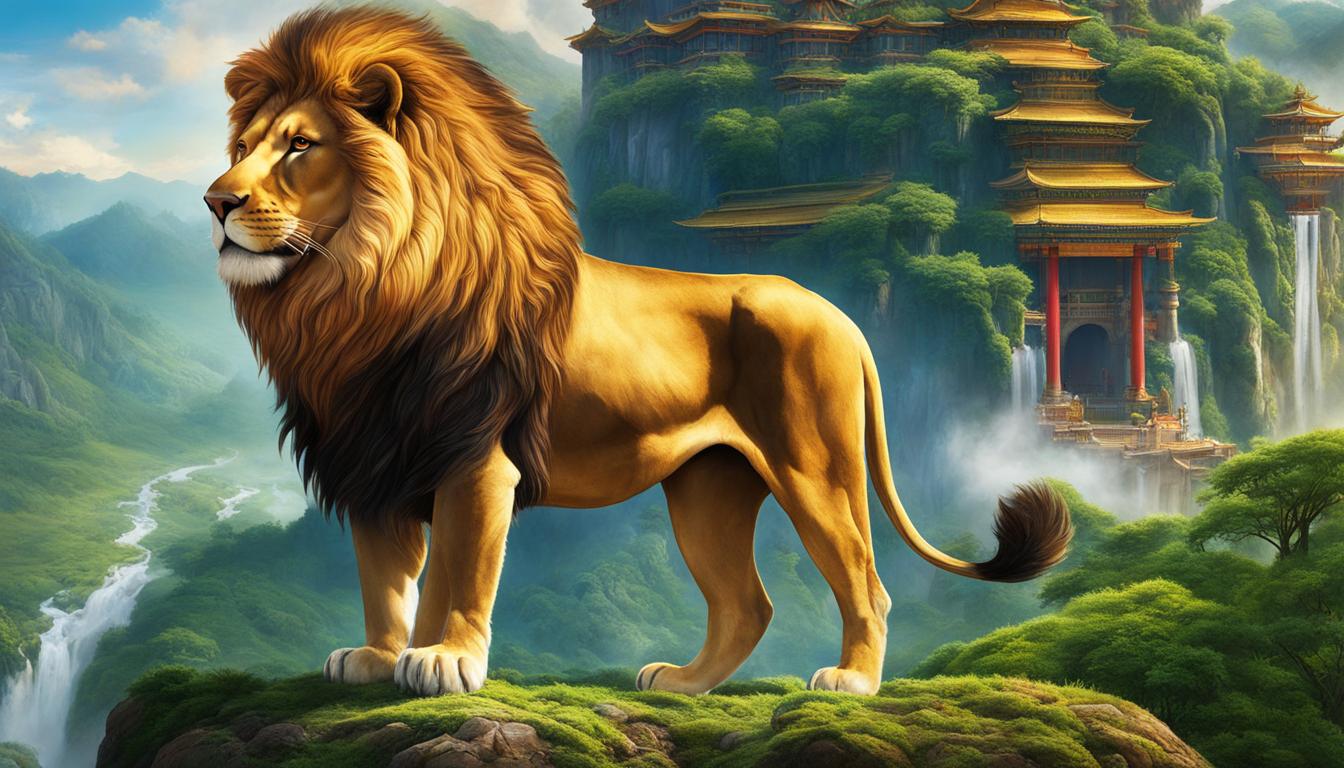Lions have held a significant place in various cultures around the world for thousands of years. They have been depicted in ancient cave paintings and sculptures, symbolizing strength, courage, and nobility. In ancient African cultures, lions were revered as sacred animals, associated with deities and considered as guardians of the land. Lions have also been important symbols in ancient Egypt, where they were worshipped as powerful deities and associated with the annual flooding of the Nile. The cultural significance of lions can be found in art, literature, and religious practices across different cultures.
Key Takeaways:
- Lions have been symbolically significant in cultures globally for centuries.
- They represent strength, courage, and nobility.
- Ancient African cultures viewed lions as sacred animals and guardians of the land.
- Lions were worshipped in ancient Egypt as powerful deities.
- The cultural significance of lions is evident in art, literature, and religious practices.
Historical and Mythological Depictions of Lions
Lions have a rich history of being depicted in various cultural and mythological contexts. Their symbolism can be found in ancient art, literature, and religious texts, showcasing their enduring significance throughout history.
Mythological Representations
In ancient Mesopotamia, lions were revered as symbols of kingship and power. They were often depicted in reliefs and sculptures, showcasing their association with royalty and leadership.
One notable mythological representation of lions can be found in ancient Greece, where the Nemean lion played a prominent role. According to legend, the Nemean lion was a monstrous creature that terrorized the region of Nemea. It was eventually slain by the hero Heracles as part of his Twelve Labors, representing the triumph of strength and courage over adversity.
Artistic Depictions
Lions have also been featured extensively in art throughout history. Their regal and majestic attributes have made them popular subjects for sculptures, paintings, and other artistic forms.
“The lion is not only a symbol of strength, but also a representation of royalty and nobility in many cultures. Artists have captured the essence of these qualities through their stunning lion portrayals, creating timeless works of art that continue to inspire and captivate audiences.”
– Art Critic
They have been depicted in various poses, often showcasing their dominance and power. Artists have used their artistic skills to bring out the intricate details of the lion’s mane, muscular physique, and fierce expressions, making these artworks visually engaging and captivating.
| Artwork | Artist | Year |
|---|---|---|
| The Lion Hunt | Eugene Delacroix | 1855 |
| Lion Attacking a Dromedary | Eugène Delacroix | 1855 |
| Study of a Lion | Leonardo da Vinci | 1517 |
These artistic depictions of lions not only showcase their physical attributes but also convey their symbolic meaning, evoking emotions and thoughts in the viewers.
In conclusion, the historical and mythological depictions of lions highlight their cultural and symbolic significance across different civilizations. Their presence in art, literature, and mythology serves as a testament to their enduring legacy as powerful and revered creatures.
Lions in African Cultural Traditions
Lions hold a special place in African cultural traditions, symbolizing strength, bravery, and leadership. Across the continent, lions are deeply respected and revered for their majestic presence and powerful characteristics. In many African cultures, wearing lion-themed adornments or clothing during ceremonies is a way to demonstrate a connection to ancestral roots and invoke ancestral strength. Lions are seen as guardians, embodying the spirit of the land and protecting their communities.
Symbolism and Meaning
Within African cultural traditions, lions represent more than just physical strength. They embody the essence of leadership, courage, and nobility. The lion’s roar is believed to carry spiritual power and is often associated with authority and divine wisdom. Lions are seen as models of bravery and resilience, inspiring individuals to confront challenges with courage and determination.
“The lion is the symbol of strength, courage, and leadership in our culture. Wearing lion-themed adornments during ceremonies is a way to honor our ancestors and tap into their strength.” – Elder from an African tribe
Lions also play a significant role in contemporary African societies. They often serve as national symbols, representing unity, pride, and sovereignty. The presence of lions in the national emblems and flags of several African countries is a testament to their cultural significance. Furthermore, lions contribute to local economies through wildlife tourism, attracting visitors from around the world who are eager to witness the beauty and grandeur of these magnificent creatures.
| African Cultural Traditions | Lion Symbolism |
|---|---|
| Leadership | Representing strength and bravery in leadership roles |
| Ceremonies and Rituals | Evidence of ancestral connection and invocation of ancestral strength |
| Contemporary Society | National symbols of unity, pride, and sovereignty |
| Wildlife Tourism | Attracting visitors and contributing to local economies |
The rich symbolism surrounding lions in African cultural traditions reflects the deep reverence and respect that Africans hold for these majestic creatures. By honoring their cultural significance and actively participating in lion conservation efforts, we can ensure that future generations continue to appreciate and benefit from the profound symbolism of lions in African cultures.
Conservation Challenges and Efforts
Lions, despite their cultural significance, face numerous conservation challenges that threaten their survival. The main challenges include habitat loss, human-wildlife conflict, and illegal hunting. Rapid urbanization and agricultural expansion are resulting in the loss of lion habitats, forcing these majestic creatures into smaller fragmented areas. This fragmentation leads to increased competition for resources, making it harder for lions to thrive.
Human-wildlife conflict arises when lions come into contact with local communities. As lions encroach on human settlements in search of food, livestock becomes vulnerable to predation. In response, people often resort to retaliatory killing, posing a significant threat to lion populations.
Illegal hunting, including poaching for their body parts or trophy hunting, further exacerbates the conservation challenge. The demand for lion bones and other body parts in traditional medicine and the trophy hunting industry puts additional pressure on lion populations.
Conservation Efforts
Recognizing the urgent need to protect lions and their habitats, various conservation initiatives have been launched. African nations and conservation organizations are working together to address the conservation challenges. These efforts include:
- Community-based conservation projects: Engaging local communities in conservation efforts helps promote coexistence and reduce human-wildlife conflict. By involving communities in decision-making processes and providing alternative livelihood opportunities, these projects foster a sense of ownership and responsibility towards lion conservation.
- Anti-poaching measures: Strengthening anti-poaching efforts through increased patrolling, ranger training, and the use of technology such as drones and camera traps helps combat illegal hunting and protect lion populations.
- Habitat restoration: Restoring and protecting lion habitats, including the creation of protected areas and wildlife corridors, plays a crucial role in ensuring the long-term survival of lions. These efforts help prevent further habitat loss and fragmentation.
By implementing these conservation initiatives, we can safeguard the future of lions and maintain their cultural and ecological significance. It requires collaboration between governments, local communities, conservation organizations, and the public to secure a sustainable future for these magnificent creatures.
| Conservation Challenges | Conservation Efforts |
|---|---|
| Habitat loss | Habitat restoration and protection |
| Human-wildlife conflict | Community-based conservation projects and increased anti-poaching efforts |
| Illegal hunting | Anti-poaching measures and law enforcement |
Conclusion
The cultural and symbolic significance of lions spans across different cultures throughout history. From ancient civilizations to contemporary societies, lions have been associated with strength, courage, and nobility. They are revered as powerful deities, protectors, and symbols of national pride.
The conservation of lions and their habitats is crucial to preserving their cultural significance and ecological role. By working together to protect these magnificent creatures, we can ensure that they continue to hold their rightful place in cultural symbolism for generations to come.
Lions hold a prominent position in religious symbolism as well. They have been revered as sacred animals in ancient African cultures and worshipped as powerful deities in ancient Egypt. Their representation in religious practices and beliefs further highlights their cultural and symbolic importance.
As we navigate the challenges faced by lions, it is essential to remember the deep-rooted cultural and symbolic significance they hold. By valuing and conserving these majestic creatures, we not only protect their existence but also preserve the rich heritage and symbolism associated with lions.
What is the significance of lion prides in cultural and symbolic contexts?
The lion pride structure and significance hold immense cultural and symbolic importance. In various societies, lion prides are revered as powerful symbols of strength, courage, and leadership. They represent unity and community, embodying the values of cooperation and family bonds. The hierarchical structure within a pride also serves as a metaphorical reflection of social roles and responsibilities, emphasizing teamwork and loyalty.
FAQ
What cultural and symbolic significance do lions have?
Lions have held a significant place in various cultures around the world for thousands of years. They have been depicted in ancient cave paintings and sculptures, symbolizing strength, courage, and nobility. In ancient African cultures, lions were revered as sacred animals, associated with deities and considered as guardians of the land. Lions have also been important symbols in ancient Egypt, where they were worshipped as powerful deities and associated with the annual flooding of the Nile. The cultural significance of lions can be found in art, literature, and religious practices across different cultures.
What are some historical and mythological depictions of lions?
In ancient Mesopotamia, lions were regarded as symbols of kingship and were depicted in reliefs and sculptures. In ancient Greece, the Nemean lion was a prominent figure in mythology, representing strength and power. Lions have also been featured in art and literature throughout history, often symbolizing courage, royalty, and nobility. Their imagery can be found in ancient sculptures, paintings, and literary works, adding to their cultural significance.
How are lions symbolized in African cultural traditions?
Lions have a particularly strong cultural significance in African traditions. They are seen as symbols of strength, bravery, and leadership. In many African cultures, wearing lion-themed adornments or clothing during ceremonies demonstrates a connection to ancestral roots and ancestral strength. Lions also play a central role in contemporary African societies, where they are often national symbols representing unity, pride, and sovereignty. They contribute to local economies through wildlife tourism, attracting visitors from around the world who want to witness the beauty and majesty of these magnificent creatures.
What are the conservation challenges and efforts for lions?
Despite their cultural significance, lions face numerous conservation challenges. Habitat loss, human-wildlife conflict, and illegal hunting pose significant threats to their survival. In response, African nations and conservation organizations have launched various initiatives to protect lions and their habitats. These efforts include community-based conservation projects, anti-poaching measures, and habitat restoration. The goal is to ensure the long-term survival of lions and maintain their cultural and ecological importance.
Why is the conservation of lions important?
The cultural and symbolic significance of lions spans across different cultures throughout history. From ancient civilizations to contemporary societies, lions have been associated with strength, courage, and nobility. They are revered as powerful deities, protectors, and symbols of national pride. The conservation of lions and their habitats is crucial to preserving their cultural significance and ecological role. By working together to protect these magnificent creatures, we can ensure that they continue to hold their rightful place in cultural symbolism for generations to come.











